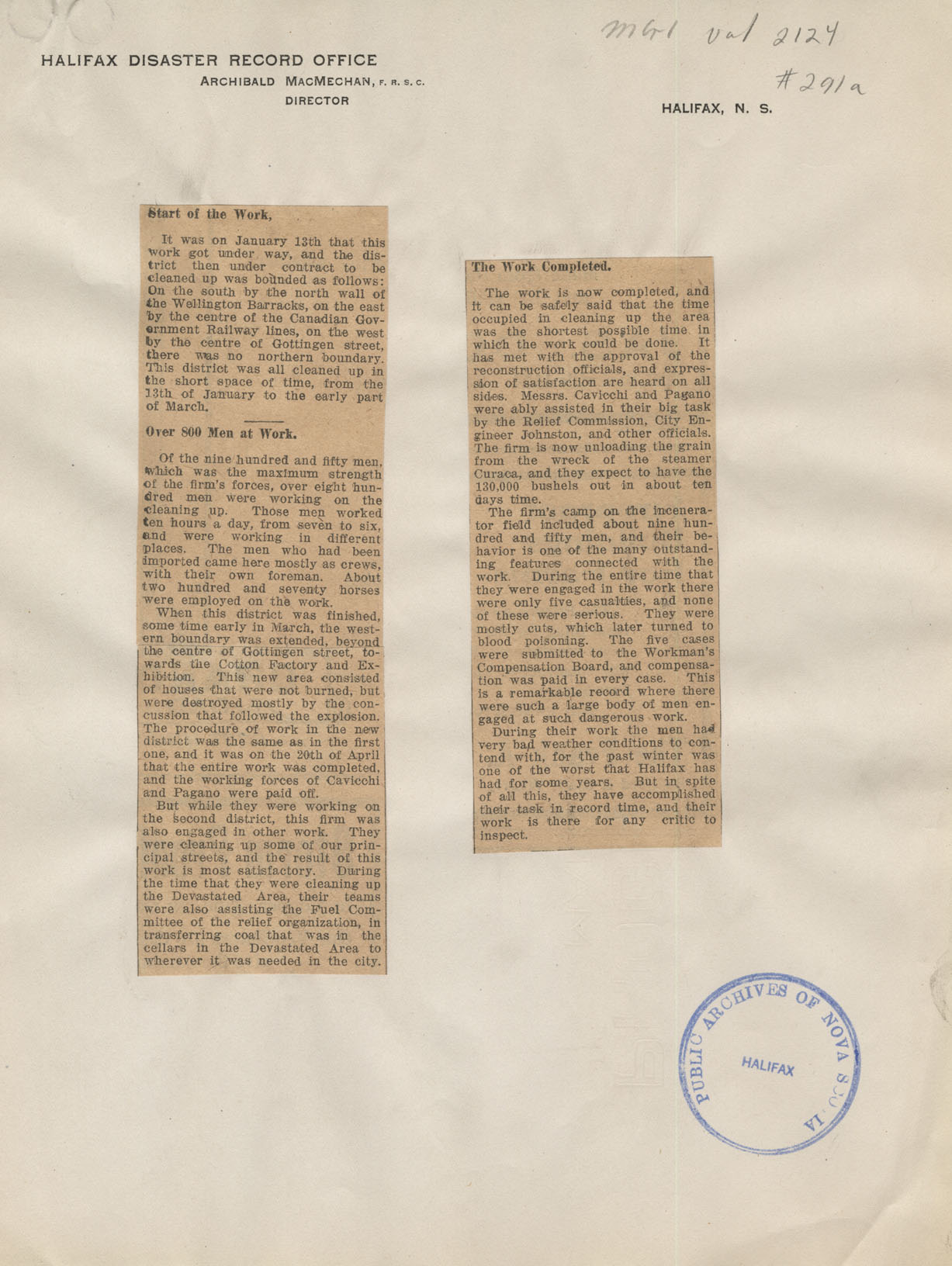Nova Scotia Archives
Archibald MacMechan
Halifax Disaster Record Office Materials
Morning Chronicle, "Cleared the Devasted Area in Record Time"
27 April 1918. — 2 pages : 30 x 40 cm.
note: transcription publicly contributed - please contact us with comments, errors or omisions
HALIFAX DISASTER RECORD OFFICE
ARCHIBALD MACMECHAN, F.R.S.C.
DIRECTOR
HALIFAX, N. S.
Start of the Work,
It was on January 13th that this work got under way, and the district then under contract to be cleaned up was bounded as follows: On the south by the north wall of the Wellington Barracks, on the east by the centre of the Canadian Government Railway lines, on the west by the centre of Gottingen street, there was no northern boundary. This district was all cleaned up in the short space of time, from the 13th of January to the early part of March.
Over 800 Men at Work.
Of the nine hundred and fifty men, which was the maximum strength of the firm's forces, over eight hundred men were working on the cleaning up. Those men worked ten hours a day, from seven to six, and were working in different places. The men who had been imported came here mostly as crews, with their own foreman. About two hundred and seventy horses were employed on the work.
When this district was finished, some time early in March, the western boundary was extended, beyond the centre of Gottingen street, towards the Cotton Factory and Exhibition. This new area consisted of houses that were not burned, but were destroyed mostly by the concussion that followed the explosion. The procedure of work in the new district was the same as in the first one, and it was on the 20th of April that the entire work was completed, and the working forces of Cavicchi and Pagano were paid off.
But while they were working on the second district, this firm was also engaged in other work. They were cleaning up some of our principal streets, and the result of this work is most satisfactory. During the time that they were cleaning up the Devastated Area, their teams were also assisting the Fuel Committee of the relief organization, in transferring coal that was in the cellars in the Devastated Area to wherever it was needed in the city.
The Work Completed.
The work is now completed, and it can be safely said that the time occupied in cleaning up the area was the shortest possible time in which the work could be done. It has met with the approval of the reconstruction officials, and expression of satisfaction are heard on all sides. Messrs. Cavicchi and Pagano were ably assisted in their big task by the Relief Commission, City Engineer Johnston, and other officials. The firm is now unloading the grain from the wreck of the steamer Curaca, and they expect to have the 130,000 bushels out in about ten days time.
The firm's camp on the incenerator field included about nine hundred and fifty men, and their behavior is one of the many outstanding features connected with the work. During the entire time that they were engaged in the work there were only five casualties, and none of these were serious. They were mostly cuts, which later turned to blood poisoning. The five cases were submitted to the Workman's Compensation Board, and compensation was paid in every case. This is a remarkable record where there were such a large body of men engaged at such dangerous work.
During their work the men had very bad weather conditions to contend with, for the past winter was one of the worst that Halifax has had for some years. But in spite of all this, they have accomplished their task in record time, and their work is there for any critic to inspect.
[written at top of page]
MG 1 vol 2124 number 291a
Reference: Archibald MacMechan Nova Scotia Archives MG 1 volume 2124 number 291

